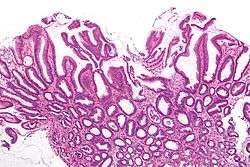Reactive gastropathy
| Reactive gastropathy | |
|---|---|
 | |
| Micrograph of a reactive gastropathy. H&E stain. | |
| Classification and external resources | |
| eMedicine | article/1962893 |
Reactive gastropathy, also chemical gastropathy, is an abnormality in the stomach caused by chemicals, e.g. bile, alcohol, and characteristically has minimal inflammation.
Cause
Reactive gastropathy has a large number of causes, including:
- Alcohol abuse.
- Bile reflux, such as may be seen post-Billroth II.
- NSAIDs.
Diagnosis
The diagnosis is by examination of tissue, e.g. a stomach biopsy.
It is characterized, histologically, by:[1]
- foveolar hyperplasia with gland tortuosity and dilation,
- smooth muscle hyperplasia in the lamina propria, and
- scant or minimal inflammation, i.e. lack of large numbers of neutrophils and plasma cells.
Relation to gastritis
Reactive gastropathy is morphologically distinct entity[2][3] that can be separated from gastritis, which by definition has a significant inflammatory component.
As a reactive gastropathy may mimic a (true) gastritis symptomatically and visually in an endoscopic examination, it may incorrectly be referred to as a gastritis. Even aware of the underlying etiology of the pathologic process, e.g. NSAID use, the label "chemical gastritis" is applied to a chemical gastropathy.
See also
Additional images
 Low mag.
Low mag. High mag.
High mag.
References
- ↑ Genta, RM. (Nov 2005). "Differential diagnosis of reactive gastropathy.". Semin Diagn Pathol. 22 (4): 273–83. PMID 16939055. doi:10.1053/j.semdp.2006.04.001.
- ↑ Pashankar, DS.; Bishop, WP.; Mitros, FA. (Nov 2002). "Chemical gastropathy: a distinct histopathologic entity in children.". J Pediatr Gastroenterol Nutr. 35 (5): 653–7. PMID 12454581. doi:10.1097/00005176-200211000-00012.
- ↑ Dixon, MF.; O'Connor, HJ.; Axon, AT.; King, RF.; Johnston, D. (May 1986). "Reflux gastritis: distinct histopathological entity?". J Clin Pathol. 39 (5): 524–30. PMC 499914
 . PMID 3722405. doi:10.1136/jcp.39.5.524.
. PMID 3722405. doi:10.1136/jcp.39.5.524.